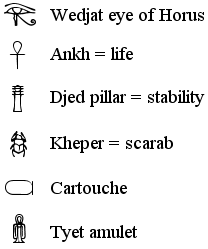 Here are some talismans, which were often used as jewelry in ancient Egypt.
Here are some talismans, which were often used as jewelry in ancient Egypt.
The first is the Wedjat eye of Horus, sometimes called the eye of Ra. It was Horus’ healed eye.
The second is the ankh which meant life or to live. It was originally a sandal strap, the round part going around the ankle. The two words “sandal strap” and “life” sounded the same, so the sandal strap came to represent life, by what is known in linguistics as the “rebus principle.”
The Djed pillar or column represented stability.
Kheper (or khepper) was a scarab beetle, and was associated with creation or rebirth, because large quantities of these beetles seem to be born from nothing right out of the ground and from balls of dung. Words and names were often inscribed on metallic scarabs.
Nowadays, the cartouche (a loop or two of rope) is a popular piece of jewelry, usually containing a person’s name. In ancient times, only the king (or queen or sometimes high priest) had his name in a cartouche. Other people just had their names spelled out, with perhaps a sign to indicate that the name was that of a man or woman.
The Tyet talismans was apparently associated with life and welfare.
MOST COMMENTED
Spells
Spell to make someone forget a Secret
Spells
Conjuring Raw Energy – A ritual spell to conjure raw energy that you may put to use.
Spells
Getting Over Spell – A spell used to get over someone you love or loved
African talismans
African talisman – general facts
Zodii si fixatii
Zodia Berbec
Zodii si fixatii
Zodia Taur
Zodii si fixatii
Zodia Scorpion